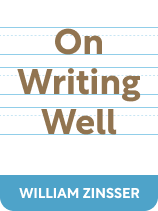

This article is an excerpt from the Shortform book guide to "On Writing Well" by William Zinsser. Shortform has the world's best summaries and analyses of books you should be reading.
Like this article? Sign up for a free trial here .
What are the three points of view in writing? Which point of view should you choose?
There are three common points of view in writing: first person, second person, and third person. The first thing you should decide when writing a narrative piece is which point of view you are going to use.
Here are some things to consider when choosing which point of view to use.
What Point of View Will You Use?
One question you should ask yourself when writing is, “What point of view will I use?” Your point of view is how you narrate your piece. Your point of view establishes a relationship with the reader since it’s how you’ll refer to yourself throughout the story.
There are three points of view in writing: first, second, and third person.
- First person uses self-referential pronouns, such as “I” and “we.” In first person, the writer is an active participant in the story since her observations are included.
- Second person uses pronouns like “you.” In second person, the writer is more removed from the story than in first person.
- Third person uses pronouns like “he,” “she,” and “they.” In third person, the writer is the most removed from the story, acting as an observer rather than a participant.
Whatever point of view you decide on, make sure it’s consistent throughout your piece so your reader doesn’t question your reliability as a narrator. If you switch points of view in your writing, you’ll confuse your reader. For example, if your friend Beth emails you about her trip to the beach and says, “I had such a great time! The water was freezing, but Beth still went swimming,” it would be confusing as she switches from first person (“I had such a great time!”) to third person (“Beth went swimming”).
How to Choose a Point of View
In addition to being an important constraint in writing, other experts believe point of view can help you create certain effects. When choosing a point of view, consider what elements you want to highlight:
1) First person: As Zinsser notes, using “I” and “me” is the point of view that will bring you closest to the story. Use first person to create a closer relationship with the reader. But the story will also be limited to your knowledge and experience, which means the reader will find out information along with you. If you want to describe how someone else felt or thought, you’ll do so through your own words and understanding of their feelings.
2) Second person: This perspective refers to a general “you,” which requires the reader to suspend their disbelief and become another “you.” Second-person is commonly used in instruction manuals. But other times, second-person narrators refer to themselves (not the reader) as “you” instead of “I.” This lets the writer distance themselves from the narrative.
3) Third person: This perspective will create distance between the narrator and the story. This isn’t necessarily a bad thing—perhaps you want to create a sense of distance or objectivity in your story. Third-person also has two forms:
- Third person limited: This point of view focuses on only one person’s thoughts and feelings, and it might be a good choice if you’re writing a biography.
- Third person omniscient: The narrator offers an objective look at multiple peoples’ points of view. It’s a common point of view in journalistic articles.
Additionally, while Zinsser believes you should keep your point of view consistent through a piece of writing, some authors change perspective for artistic effect. For example, in the semi-autobiographical novel We the Animals, Justin Torres initially writes in plural first person: “We were six snatching hands, six stomping feet; we were brothers, boys, three little kings locked in a feud for more.” Then later in the book, he transitions to first-person singular, using “I” more than “we.” This choice is meant to represent the boys’ coming of age and one brother’s feelings of isolation. If you decide to experiment with points of view, make sure you do so with a specific purpose in mind, as Torres did.

———End of Preview———
Like what you just read? Read the rest of the world's best book summary and analysis of William Zinsser's "On Writing Well" at Shortform .
Here's what you'll find in our full On Writing Well summary :
- A back-to-basics approach to the craft of writing
- How to practice simple, clear, and engaging writing—even if you're not a writer
- How to effectively put your ideas into words






